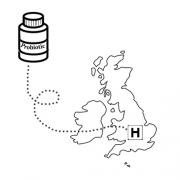How metabolites help us to understand the effect of gut microbes on health
By Dr. Anisha Wijeyesekera, University of Reading, UK
Much literature relating to the gut microbiota has focused on microbial composition (for example, using culture-dependent and -independent molecular biology approaches). Composition is important; knowing which microbes are present in a community enables us to gain insight into population dynamics and how these may be affected by disease, lifestyle and environmental factors (including diet). However, composition does not provide information on microbial function, and considering the gut contains the most metabolically active microbial community in the whole body, it is thus equally as important to be able to answer the question “what are the microorganisms doing”? This is of particular importance with respect to better understanding the impact of dietary interventions such as prebiotics, probiotics and other ‘biotics on health, where health benefits conferred on the host are mediated via the gut microbiota.
Investigating microbial function
Advances in phenotypic analytical technologies (for example, high-throughput sequencing, biochemical analysis, as well as bioinformatics and other multivariate data analysis approaches), have resulted in a stepwise change in our understanding of microbial function. Metabolic phenotyping (also referred to as metabolomics, metabonomics or metabolic profiling) is an exciting field in systems biology that provides information on the multiple metabolic mechanisms taking place in a system, at a given moment in time (see here). This top-down approach enables high-throughput detection and quantification of low molecular weight molecules present in a biological sample at the time of sampling, without a priori knowledge of metabolites present. Hence, it is ideally suited to augment and complement information obtained from microbial profiling approaches such as metataxonomics, to gain deeper insight into microbial function.
Metabolic phenotyping is conducted by applying analytical chemistry technologies (typically, 1H-nuclear magnetic resonance spectroscopy, and/or mass spectrometry often with chromatographic separation techniques such as gas chromatography and liquid chromatography (for prior separation of molecules followed by detection)) to capture a biochemical snapshot of a sample. In human samples (e.g. urine, blood plasma/serum and stool), metabolites detected using metabolic phenotyping are low molecular weight molecules and include intermediate and end by-products of endogenous host metabolic pathways (e.g. TCA cycle, amino acid metabolism), but also exogenous signals arising from diet, drugs and other lifestyle and environmental stimuli, including products of microbe-host co-metabolism, which provide insight into host-gut microbiota interactions. These include short-chain fatty acids (predominantly acetate, butyrate and propionate, which have a key role in host energy metabolism), bile acids (involved in the gut-liver axis), biogenic amines (involved in the gut-brain axis) and vitamins. Metabolic phenotyping, which provides functional assessment of the gut microbiota and captures information on microbial metabolic activity following ‘biotics intervention, can aid in forming hypotheses about microbial activity that may lead to health benefits.
Challenges in determining the functions of microbes
Nevertheless, functional assessment of the microbiota remains analytically challenging. For example, human metabolic phenotypes contain information relating to different forms of optically active isomers, such as lactate and amino acids (where D- forms originate from bacteria). These enantiomers cannot be differentiated using standard metabolic phenotyping experiments, and it would be important particularly in studies identifying potential biomarkers of disease, to understand the origin of these compounds. Hence, we and others have also conducted mechanistic studies using in vitro human gut model systems (e.g. the model developed by Macfarlane et al., 1998, which has been validated against gut contents from sudden death victims and give a very close analogy to bacterial activities and composition in different areas of the hindgut), Metabolic screening of fermentation samples using metabolic phenotyping approaches provides a unique opportunity to capture dynamic microbial metabolism that is reflective of the gut microbiome in vivo, and removes contributions derived from host physiological processes (see here).
Unravelling the close interplay between microbes and host, using approaches such as metabolic phenotyping, not only provides insight into host-gut interactions, but aids our understanding of the alterations in gut microbiota mediated mechanisms that result in disease, and which demonstrate potential as therapeutic targets. More research in this area will aid in deepening understanding of the role of the gut microbiota in health and disease, and aid in the design of interventions targeting the gut microbiota (for example, the development of functional foods) for therapeutic benefit.















